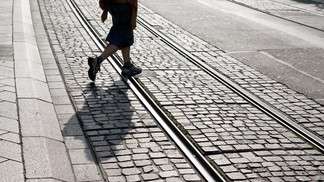People are still moving as much, but it's taking them longer

In the cantons of Geneva and Vaud, people are using their cars less often and their overall travel time is increasing. More than half the trips are for leisure activities and shopping.
Policies encouraging public transportation and foot and cycle travel have been in place for more than two decades. Their effectiveness is reflected in the latest statistics coming from the cantons of Geneva and Vaud; people have changed their travel behavior. Data for the cantons of Geneva and Vaud from the Federal Office of Statistics (FOS), carefully combed and analyzed by EPFL researchers, show that inhabitants are increasingly forgoing their cars for public transportation, walking or cycling. The number of kilometers they're traveling hasn't changed; however, it's taking them longer to get where they're going.
"The result of our research is a detailed picture of the mobility patterns of the inhabitants of the two cantons and the major changes recorded since 2000. No other Swiss canton has done this analysis to date," says study coordinator Sébastien Munafò. The study's objective was to analyze the 2010 statistics from the FOS's Mobility and Transports Microcensus, and compare it with those of 2000 and 2005.
An hour and a half of daily travel time
The principal results indicate several common tendencies in the two cantons that border Lake Geneva. First, an overall reduction in the use of automobiles. The percentage of households without a car increased (one in four GE, one in five VD) and this should continue to increase given that young people are obtaining their drivers' licences later, or sometimes not at all. Among 28-25 year olds, nearly half of those responding to the study did not have a license to drive (48% GE, 42% VD).
Individual trips, which are not decreasing, are more often taken using public transportation, walking or cycling. The number of people with public transportation passes increased by 16 percentage points between 2000 and 2010 (50% GE, 46% VD). In addition, walking is currently quite popular, representing 37% of trips by those in Geneva (+8 points in 10 years) and 31% of trips in Vaud (+6 points). "In the city of Geneva, walking and cycling now represent the majority of inhabitants' trips (52%), confirming the importance of this kind of mobility in this dense region of the canton," says Munafò, who is a researcher in EPFL's Laboratory of Urban Sociology (LaSUR) and the University of Geneva Mobility Observatory. In fact, Geneva boats the most walkers of anywhere in Switzerland.
In the two cantons, every inhabitant spends an average of 1.5 hours (83 minutes) per day getting from place to place. This time is increasing, although the average distance traveled per day (air travel excluded) – 31 km in Geneva and 41 km in Vaud – is slightly decreasing compared to 2000. For Vincent Kaufmann, Director of LaSUR, this can be explained by heavier road traffic, increasing use of public transportation, and more travel done via walking or cycling, all of which tend to increase average travel time.
Leisure leads the way
The Microcensus also reveals that, as in 2000 and 2005, the inhabitants of the two cantons travel mostly for leisure. This motive represents 38% of all trips taken. "Free time represents, in reality, a large portion of our lives and thus the trips we take. The overall increase of the number of retirees in the population adds to this," says Munafò. "In addition, even though we're very conscious of trips to and from work, there are rarely more than two of these per day, five times a week." In close second in terms of trips after leisure activities (23% GE, 21%VD), comes shopping (20% GE, 22% VD). The researchers think that the increase in the number of stores open in the evening and on Sundays, for example in train stations and service stations, probably plays a role in this.
Inhabitants of Geneva are traveling from home to work less by car and more by foot or bicycle (these two increased from 23% - 31% over ten years). They are, however, increasingly fond of their motorbikes; the number of motorbike/cycle commuters has more than doubled among the inhabitants of suburban Geneva (from 7% to 15%). In Vaud, these trends are similar, although inhabitants also favor using the train for their home-work travel, with a doubling in the number of train commuters to 7% (+4 points).
Geneva's inhabitants on the go
This study, coordinated by EPFL's Transportation Center, also highlights cantonal particularities. Geneva, for example, which has long been a destination for commuters, is now experiencing an outflux of its inhabitants, particularly those of the inner city, as they commute to jobs in suburban neighborhoods or the wider Lake Geneva region.
In Vaud, the other mandate with the public transportation authority of Lausanne, it is apparent that the metropolitan region of Lausanne has enormously benefited from an overhaul of the public transportation offer between 2005 and 2010, which has accentuated the decrease in automobile use and the increase in the use of public transportation, walking and cycling. "People in Vaud enthusiastically embraced the improved public transport offer, so much so that some regional lines have become victims of their success at rush hour," says Christian Liaudat, head of mobilty projections in the mobility service in the Canton Vaud.
Provided by Ecole Polytechnique Federale de Lausanne



















